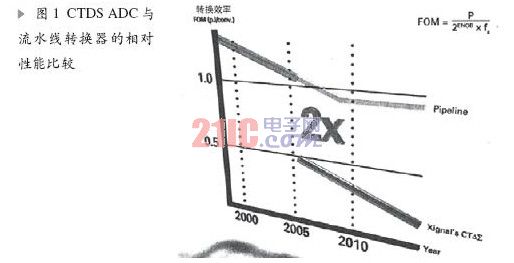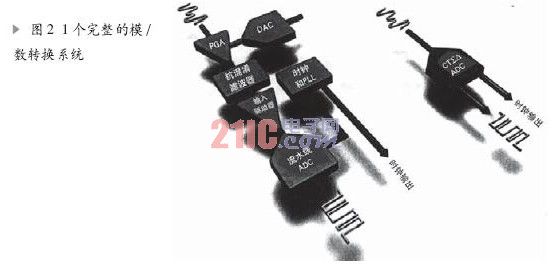Application of CTDS conversion technology in medical ultrasound system
So far, designers have faced trade-offs in ADC selection. Pipeline converters provide high resolution and wide dynamic range, but their power consumption is quite high. In another method, the discrete-time ΔΣ converter hardly requires much power, but it is strictly limited by the speed.
CTDS ADC
Continuous time ΔΣ (CTDS) technology can fill the gap of the converter. Xignal's recently launched products can work at 40Msample / s (equivalent to 50 ~ 60Msample / s of pipeline converter), with 12-bit or 14-bit resolution, high functional integration (including accurate on-chip clock source), It consumes only 70mW. This product also has a resistance input stage, which is easy to drive without resorting to a buffer amplifier.
Figure 1 shows the relative performance comparison between CTDS ADC and pipeline converter. This figure is based on IEEE approved FOM (performance factor) measurement. FOM is an energy measurement for each conversion. FOM also shows the future scale of the process structure, and continuous-time ΔΣ devices will develop along the roadmap that gives higher performance levels.

Figure 2 shows a complete analog-to-digital conversion system. The diagram on the left hand side shows that a complete system requires five external circuit elements for the pipeline converter. They are programmable gain amplifiers (gain control through separate DAs); anti-aliasing filters to remove noise; input drivers that buffer the capacitive inputs of the ADC itself; high-performance clocks and phase-locked loops that provide accurate timing references. In contrast, the continuous-time ΔΣ implementation method removes the required anti-aliasing filtering and input drivers, while the Xignal implementation method integrates all other functions on-chip.

The advantages of CTDS conversion technology are: faster and simpler system design, lower power consumption, and no need to compromise on dynamic range or speed. In multi-channel applications, the above-mentioned advantages of CTDC ADCs can add value and enable designers to adopt new and beneficial system structures, which was not possible before. This technology has a wide range of applications, including all areas of the electronics industry, especially where analog signals from various sensors need to be converted to digital signals.
Medical ultrasound applications
In a medical ultrasound system, an ultrasound transducer emits ultrasound waves, and the ultrasound waves are reflected by the target and received by the transducer again. In order to scan a large area and focus on the target at a certain distance, the target needs to be small, and multiple transmit / receive elements need to be configured in a one-dimensional or two-dimensional array to form a beam. The focus and direction of the beam can be controlled electronically.
The transducer is connected to a data processing unit that processes data through flexible cables. Each transducing element is connected to the processing unit through its own data channel or multiplexing circuit. The high-end system has up to 512 channels, the medium-performance system has up to 256 channels, and the portable system has up to 128 channels.
According to the distance from the target to the sensor head and the nature of the target, the amplitude of the analog signal received and sent via the cable is wide. Therefore, the cable is composed of several low-loss coaxial cores, which is one of the expensive components of the ultrasound system. Nevertheless, cable losses and losses at the transducer interface are requirements for high-performance and fairly expensive receivers.
Signal integrity
If the ADC is made close to the transducer, it will improve signal integrity. Integrating the analog front end with the ADC and placing the device directly in the transducer will reduce the performance requirements of the receiver, and digital transmission is more reliable and lower cost than analog signal processing units. However, the analog front end used before the development of CDTS technology consumes up to 0.5W per channel of its pipelined ADC. This consumes up to 64W for a medium system (128 channels). The heat generated will affect the performance of the transducer head and cause great discomfort to patients and doctors. On the contrary, using the CTDS scheme in the same system consumes only 8.75W, and even consumes less power (using a multi-channel ADC device to share certain resources, such as a PLL across multiple channels). Using an 8-channel 12-bit ADC can achieve a power consumption of 40mW / channel or a 128-channel power consumption of 5.12W.
Portable systems are required to reduce the size of ultrasound scanners. In the realization of small and low-cost systems, ADC power consumption is an important design parameter. This small system conversion occurs in the transducer head or processing unit, and the system requires minimal cooling. The new system may also be battery powered, so minimizing power consumption is a more critical factor.
Continue to study
People have studied to replace the analog beamformer with a digital beamformer in continuous wave Doppler applications and process all the data from several ultrasound nodes through the same digital processing path. The increased power consumption in the digital domain can be reduced by using an advanced CMOS process with a lower power supply Voltage of 1.2V or lower. It is impossible to achieve the required performance with such low voltage general ADC technology. Continuous time ΔΣ technology can provide the required performance with 1.2V power supply and will further reduce power consumption and size with the development of CMOS process technology.
The simplified structure of the ultrasound system using CTDS ADC in the transducer head is shown in Fig. 3. In addition to ADCs, active transducers include low-power variable gain amplifiers, serializers, and digital interfaces, which can greatly reduce the number of cables used to interconnect the main processing unit.

The advantage of CDTS ADC is to provide the required high speed and high resolution with the lowest possible power consumption. In sensor-related applications in automotive, medical, industrial, and test and measurement equipment, this technology can be used to construct new structures that bring A / D conversion close to the sensor.
Lipo Battery, Polymer Battery, Lipo Charger, RC Lipo, Lithium Polymer, Lipo Cell
Shenzhen Powercom Electronics Co., Ltd. , https://www.expowercome.com
